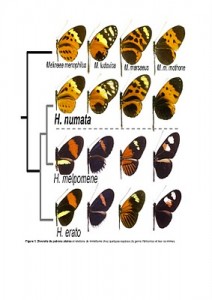Mission context :
From 2008 to the end of 2009, I joined the “Origin, Structure and Evolution of Biodiversity” laboratory, UMR 7205, from Muséum National d’Histoire Naturelle de Paris (MNHN).
Mathieu JORON’s team conducts scientific research in evolutionary genetics in order to describe the genetic and adaptive processes behind an important intra- and interspecific mimicry system in tropical, Central and South American butterflies, of the genus Heliconius.
These butterflies are a very good model for understanding how natural selection creates new species, new phenotypes and how these species interact with each other.
caption id=”attachment_157″ align=”alignright” width=”212″] Mimetic complex in several species of butterflies of the genus Heliconius and Melpomene[/caption]
Mimetic complex in several species of butterflies of the genus Heliconius and Melpomene[/caption]
The Heliconius are butterflies with a wide variety of wing patterns. In addition, each species is composed of several geographical populations which also have different colour patterns (lire this article).
Thus, in the same geographical zone, we find butterflies presenting the same wing colours but belonging to different species. The most surprising is that some species, populations very close phylogenetically present very different patterns, and others, distant phylogenetically, have coloration inseparable from each other.
The majority colouring of a geographical region is similar to that of the mimed species which belongs to different genera such as Melpomene. This is because the latter are toxic species and therefore Heliconius benefit from this advantage. Natural selection encourages and tends individuals to resemble each other (density-dependent selection) (see recall on mimicry).
All these populations and species constitute a vast mimetic complex in constant evolution.
To learn more about the evolutionary history and genetic mechanisms at the origin of coloration in these butterflies, I invite you to read this article.
I had the chance to carry out a research mission in this context:
- to the Smithsonian Tropical Research Institute International Research Centre in Panama for 6 months (for more information)
- in French Guyana, notably at the Station des Nouragues, in the middle of the tropical forest, for 1 month (for more information)
Some of my results were published in the journal Nature/Heredity (25 March 2015) here.
Reminder on mimicry:
Why look like you’re not ?
There are two reasons for this:
- Batesian imitation : named after an English naturalist of the XIXe century, Henry Walter Bates. A harmless species adopts the physical appearance (patterns, colours, etc.) of harmful species with the aim of avoiding predators who have learned to avoid real harmful species. The mime (i.e. the harmless species) thus benefits from protection against predators without having to spend energy to consume or produce toxins. Imitation, on the contrary, suffers because predators may understand that in many cases the warning signal is not honest. Here we find the example of Heliconius.
- Mullerian imitation : named after its discoverer,Fritz Müller, a German zoologist of the XIXe century. Two unrelated toxic species have similar patterns and warning colours. The similarity of the warning colours is advantageous for both species, as the predator tends to be less mistaken. Predators learn to avoid harmful prey more effectively, since a bad predator experience with one species protects all other mullerian models. So both the mime and the model benefit from each other’s presence by sharing the burden of predators. In addition, studies have shown that Mullerian mimicry is also beneficial to the predator, as it reduces the frequency of errors during the learning of different warning signals.
- Camouflage : it consists in imitating inanimate objects of the environment like a stone, a leaf, a twig (case of phasms), a poop… Two types of camouflage can coexist homochromia is the mimeticism of colors and homotypy is the mimeticism of shapes.

